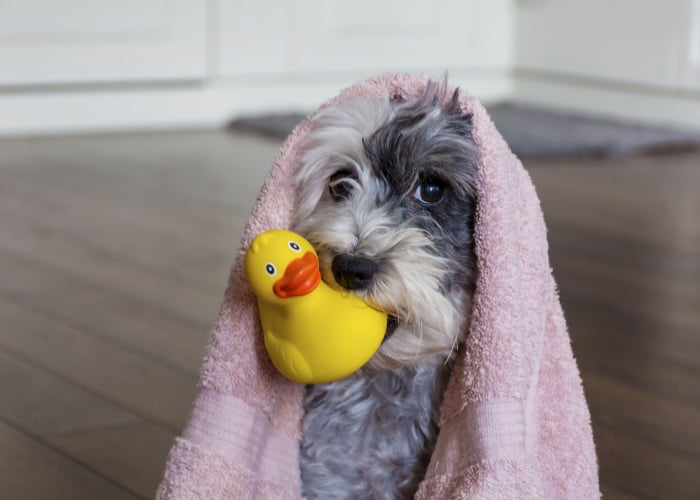Potential Risks And What To Do – Top Dog Tips

Dogs are very curious animals. But sometimes, they can get a little too curious and eat something they are not supposed to.
This is especially common for young dogs, who are naturally curious and enjoy chewing even indigestible things.
If you ever find yourself saying these statements:
“Oh no! My dog ate rubber! What should I do?”
We’re here to help you.
If your dog owns a rubber toy or you have other rubber items in your house, such as a rubber band, you should know what to do when your pup accidentally eats one of these items.
If you suspect or know that your dog ate rubber, you should first establish what kind and the size.
Remember these pieces of information or list them down, as the vet will ask these questions once you’re in contact with them.
Regarding our dogs eating inedible items, pet owners should contact their most trusted vet right away.
This blog is your ultimate guide on what to do next.
So if your dog ate a rubber toy, rubber band, or rubber, you better scroll down!
Without further ado, let’s dive in and discuss what can happen if your dog eats rubber.
My Dog Ate Rubber: What Can Happen?
“Hey, Doc! My dog ate rubber! What should I do?”
The first thing you need to do is stay calm and figure out how much rubber Fido consumes.
It’s important to keep calm in this situation.
We know it’s difficult, but dogs can sense if we are anxious and copy our stressed state.
However, dogs cannot digest rubber even with their strong stomachs.
Your best bet is that your dog can vomit the rubber, pass it through naturally, or surgically remove it.
We pet owners must monitor our dog’s stool to watch it pass because rubber, such as a rubber band, is long and stringy and can get entangled in their intestines, which can be a huge problem.
When it comes to dogs eating rubber, three possible risks can happen:
Choking
The worst thing that can happen is that dogs eating rubber can be fatal due to choking or from the damaged digestive system.
A choking dog will have difficulty breathing since the rubber band or rubber toy is stuck inside their throats.
A choking dog with no help will most likely collapse and lose consciousness. Death can follow if they are not given help immediately.
What to do if your dog is choking
The first thing you need to do is to restrain your dog gently.
A choking dog is in pain and will struggle, potentially harming you and themselves.
Next, open their mouth, pull their tongue, and look inside.
If you see that object is removable, use a tweezer by reaching into the dog’s mouth. This way, you won’t get yourself bitten.
But if it’s a matter of life and death, as pet owners, we have to put a hand in the dog’s mouth and pull out the object that’s blocking the airway.
Be careful not to push the object further down, as you may lodge it deeper.
If the object is not too big, the chances are that your pup is still getting some air, but if you push it too far, you can completely cut out the air supply.
Vets suggest exercising pressure with your fingers on the bottom of your dog’s jaw, near the throat, and pressing forward as if you want to squeeze something out.
Also, the air is still coming through when your dog is choking but conscious.
Unfortunately, they might also be overheating.
If that’s the case, cool your dog with cold water applied to its ears, feet, and belly before you go or during your ride to the vet.
Rush him to the vet immediately, even after you’ve successfully pulled out the object.
Remember that it’s better to be safe than sorry!
Blocked Digestive Tract
One dangerous effect that can come when your dog has a large amount of rubber is bowel obstruction.
Small-sized dogs are more prone to this, especially if they consume huge amounts of rubber due to their tiny bodies.
Bowel obstruction (also known as intestinal blockages) usually happens when a dog’s stomach or intestines get partially or completely blocked.
Food or waste can’t pass through the digestive tract when this happens.
A partial blockage will allow some material to get through (but still dangerous).
However, a complete blockage will completely block anything that is trying to pass through.
The more inedible item your dog eats, the higher the risk of a blockage.
Intestinal Blockage Symptoms & Treatment
Symptoms of intestinal blockages include vomiting, lethargy, diarrhea, bloating, abdominal pain, and more.
On the other hand, the cure for intestinal blockage can be surgical or non-surgical.
Different factors will determine what procedure will be needed.
For instance, the location the object has been stuck, the shape, size, and the structure of the object.
Some objects, through time, can pass on their own.
But never take that risk since intestinal blockage in dogs is best solved as early as possible.
Peritonitis
Dogs suffering from intestinal blockage are also in danger from a severe condition called Peritonitis.
Peritonitis is the inflammation of the abdomen.
This is not your ordinary stomach ache.
If your dog is suffering from a blockage, watch out for these symptoms of Peritonitis:
If you’ve noticed the signs above, call the vet immediately and ask how to proceed.
This condition is serious and can also be fatal.
Usually, Peritonitis can be treated with antibiotics and medicine to reduce inflammation.
Surgery is generally needed to remove the cause of the problem and flush the abdomen.
What To Do If Your Dog Ate Rubber
Contact your vet immediately if you know or suspect your dog ate rubber.
Foreign objects, including rubber, can cause choking or bowel obstructions.
To ensure your dog is secure and there won’t be any long-term harm, use the guide below if you’re unsure of what to do.
Remove access to Rubber
The first step is to ensure that they don’t eat more paper. Hide these paper products where your dog can’t find or reach them.
If your pup loves to go into the trash, try using trash cans with lids to deny them access to it.
Find out what type of rubber and how much.
The next thing you need to do is to determine what kind of rubber your dog ate and how much of it.
Did your dog eat a rubber band? Or maybe a rubber toy?
Check if they consumed something that has chemicals in it.
Write all of these down, including the type of rubber, the amount he ate, and when he ate it. Your vet will also need your dog’s weight.
These notes will be very valuable for vets to assess the situation properly.
Call your trusted vet
Calling your most trusted vet is the first thing you must do when your dog is in danger.
If you want to sleep soundly at night, it’s best to seek veterinary advice immediately.
If your pup ate any indigestible item, contact a vet who can properly examine the situation. The vet will decide whether or not they need to bring your pup to the clinic.
The vet will most likely ask you to come to the clinic for further examination if you own a small-sized dog or a toy dog.
Smaller-sized pups are more at risk in this situation. The vet will also ask you to hurry if your dog shows different symptoms.
Monitor their Poop and Check for signs of blockage
Monitor their poop to see if the rubber has passed.
If it doesn’t get stuck in the throat, a piece of rubber can reach the stomach within 2 hours.
Rubber is hard to break down and will be passed along the small intestine afterward.
If you own a large-sized adult dog, a small piece of rubber might pass through his feces within two days.
However, remember that it’s still best advised to contact your vet just to be safe.
Furthermore, watch out for signs of blockage.
A partial blockage will allow some material to pass through, and it can still harm our dogs.
Unfortunately, a complete blockage won’t let the material get through.
How to Prevent Your Dog From Swallowing a Rubber Band?
You can prevent your dog from swallowing or eating indigestible items such as rubber in many ways.
The following tips can help you stop your dog from swallowing rubber bands:
- Keep harmful or easily ingested items out of their reach. This includes rubber bands, hair ties, cigarettes, clothing, food wrappers, and paper.
- Take away their rubber toys as soon as they’re down playing with them.
- Monitor your dog if your pup is chewing on toys or other items.
- Throw out chew toys or rawhide bones that became small enough to fit in their mouth.
- Dispose of your trash as frequently as possible. (Some dogs love to dig in garbage cans.)
- Ensure that your cabinet doors are locked.
My Dog Ate Rubber: FAQs
What if my dog eats a little piece of rubber?
If you own a large-sized dog and it ate a small piece of rubber, it can easily pass it through. However, to be sure, it’s best to call your vet quickly.
How do you know if your dog has something stuck in his stomach?
Bowel obstruction occurs when the stomach or intestines are partially or completely blocked. Signs that your dog has something stuck in his stomach are:
- Vomiting
- Weakness
- Diarrhea
- Stomach pain
- Bloating
- Dehydration
- Loss of appetite
How long can a dog live with a blockage?
If left untreated, dogs suffering from a complete intestinal blockage can see fatal complications within 3-4 days.
Even though, given time, some foreign materials can pass on their own, it’s best to provide treatment for these kinds of situations as soon as possible.
My Dog Ate Rubber: Before You Go…
“My dog ate rubber! Should I be worried?”
Do your best to calm yourself down since there’s no need to panic yet, and assess the situation carefully.
There’s no need to panic… yet.
Dogs can’t digest rubber. Chances are that they can pass it through naturally.
Small amounts of rubber normally pass through your dogs.
However, if your dog swallowed a rubber band, there’s a possibility that it can get stuck inside them, causing an intestinal blockage.
Dogs that eat indigestible materials are also at risk of choking.
Monitor your pup closely and contact your vet as soon as possible for further assistance.
If your dog shows symptoms such as vomiting, diarrhea, weakness, or refusal to eat or drink, bring him to the vet immediately.
RELATED ARTICLES:








